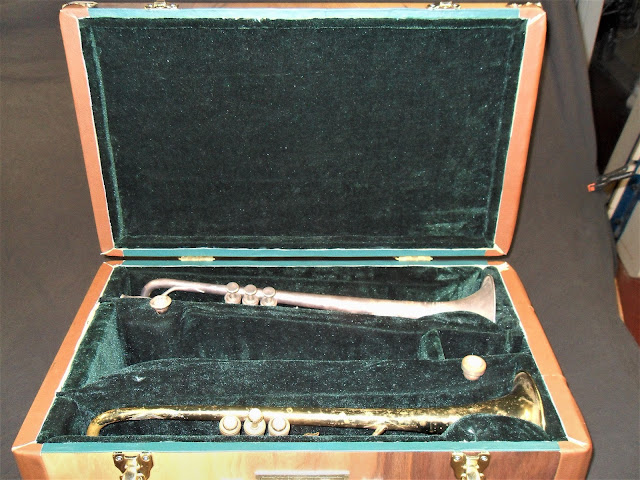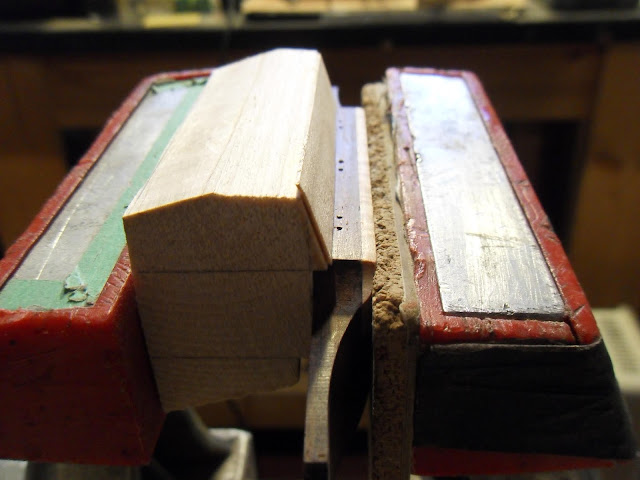So let me begin with a warning/advice for those starting out doing luthiery or woodwork.
Don't be like me and try to work around the mayhem of a disorganized shop.
Take a couple of months, or even a year if necessary, to set up your work space properly before starting any projects. I thought the soundboard had been set safely aside while I worked on other parts of the tres. That was until a desk lamp decided to fly off my bench and fall directly on the soundboard.
Aside from the split, there are two deep impact craters on the surface. So even if I were able to glue the board back together without the crack line being visible, it would still have obvious damage. Luckily, I have plenty more reclaimed redwood to make a new soundboard from. Plus, I have pieces wide enough so I won't need to add extra wood to the outside edges. Those added pieces really show up in this photo and just don't look nice, so really, it will be worth doing over.
I will glue this board back together and maybe save it for a less important project.
Back to the line inlay I had started on in the last post. A new tool needed to be made.
I realized the black-handled chisel I use for cleaning fret slots wouldn't work for carving out the channels because of its blade length. While going around the tighter curves, the back edge of the chisel would scrape along the sides of where I had just carved, leaving the channel too wide and rough. I ground down the tip of an old broken Dremel bit into a tiny flat-bottomed hook shape. I also whittled myself an ergonomic handle for it.
The fingerboard got narrowed a little to allow for the thickness of the new maple binding, which is getting glued on here with masking tape.
Once I got all the channels carved out deeply enough I inlayed veneers
into them. I used a soldering iron to bend the veneer strips into the
spiraly curves. Sorry, no pictures of the process, but here are the
rosette, fingerboard, and headcap with the veneer inlay lines complete. I
still have to inlay the dots into the drilled-out parts of the designs.
I'm trying to keep that part a surprise for now.
I also cut out the truss rod channel into the new neck wood and measured how much to cut off the end of the rod. Once it's cut shorter, it will need to get re-welded at the end. I don't weld so I'll need to look around for someone who does.
I got the new and thicker back maple planed down, joined, and rough cut to the outline. Here I have just routed a slot (OK, another channel!) along the center seam. The clamped-down straight-edge was the guide for my router base to run along. The strip which will get inlayed into the slot is getting glued up into layers with all those clips.
Here's a plane shaving from the center strip to show what it looks like.
Here is the center strip getting glued in on the left, and the inside reinforcement strip getting glued on the right with go-bars. I wet the maple in the right photo while cleaning off the glue squeeze-out. This shows how the maple will look with finish on it. Sort of.
The center reinforcement strip is made of redwood scrap from the soundboard. After it's glued onto the back, it gets rounded (like a speed bump) with my rounded edge plane and concave sanding block.
Next the strip gets notched where the back braces go through it, and the braces get glued on with go-bars. I used that square to keep the braces perpendicular to the strip.
The maple for the sides has also been planed flat with no more saw marks, but it needs to be thinned more for bending. Hopefully I can get the sides bent and the new soundboard to the point that the old one was at (or further) in not too long of a timespan.
Bending sides (especially highly figured maple like this) is arguably
the most stressful part of the process. Once that step is done, it
should be pretty smooth sailing for the rest of the build.



















































